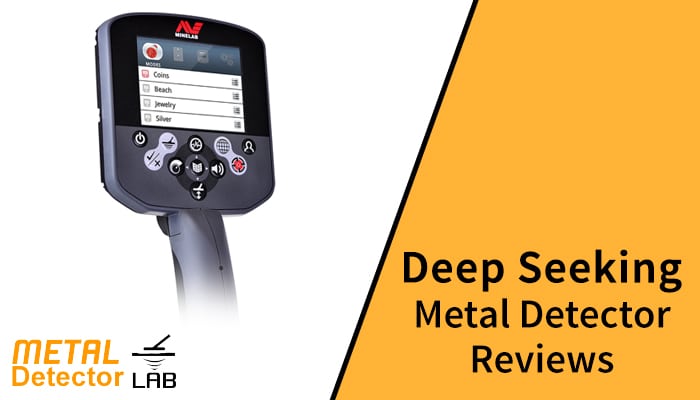Best Underwater Metal Detectors
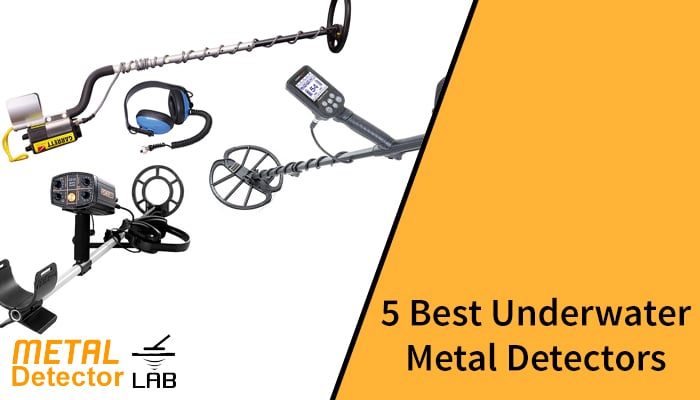
If you use metal detectors to locate jewelry and valuable objects, you already know how valuable it is to broaden your detection range to include deep water. Many metal detectors, on the other hand, won't operate much further than a few inches underwater.
Fortunately, several metal detectors are specifically designed for the use at considerable depth.
We'll take you through a step-by-step process in this article to help you choose the right underwater metal detector to fit your uses.
Top 5 Underwater Metal Detectors
1. Garrett ATX

The Garrett ATX is among the few metal detectors that can truly be used in any terrain, and it works just as well in a desert wash as it does underwater. The Garrett ATX can be submerged to a depth of ten feet in order to scan for possible targets underwater, making it an ideal metal detector for gold nugget detecting in gold-bearing rivers.
The Garrett ATX has three modes of operation underwater, the first of which is discrimination. In salt water conditions, the discrimination level on the Garrett ATX can be adjusted to 3-7, and many of the false signals will be omitted. Of course, since gold hunting takes place mostly in fresh water, there would be less problems with defective signals caused by salt conditions than there would be at the beach.
Discrimination is normally not advised for nugget hunting in ordinary situations, but given how much more difficult it is to retrieve metal targets underwater than those on dry land, this might be the simplest alternative, even if it means missing some gold nuggets.
While ground balance is not needed in discrimination mode, this approach may have the downside of reducing detection of items with low conductivity.
The Ground Balance System is the second method. This approach will significantly aid in increasing the detection rate of low-conductive objects without increasing the discrimination threshold. Ground balance is a critical skill for metal detecting, and in order to maintain the best stability, it must be balanced as the ground conditions alter. By operating the metal detector in all-metal mode, the Garrett ATX will be the most sensitive. Land balance, on the other hand, can be difficult when you are completely submerged underwater. If you are simply wading, this is probably the better option.
The normal ground balance system is the third method. This technique has a number of advantages and disadvantages. The benefit is that this approach detects the most low-conductive targets. The downside is that this approach can generate a large number of false responses as ground conditions change.
The coil should be swept smoothly and at a fixed height, just as they would on dry ground. Allowing for seamless transitions across ground conditions enables the detector to automatically adjust to the optimal level for each of the varying ground conditions.
You can read more about it in our review of the Garrett ATX.
2. Garrett Sea Hunter Mark II

Although expensive, this metal detector comes highly recommended by experts in underwater treasure hunting. In general, the blend of quality, functionality, usability, and price is excellent, which is one of the factors why users all over the world adore this model. This system completely avoids salt water and performs equally well in both freshwater and saltwater, as well as on ground.
The fact that the control box for the metal detector can be fitted to the hip or arm demonstrates increased usability, as it makes the search more convenient. The Discrete Trash Elimination system allows the user to only dig for useful items while ignoring trash.
The following are the key specifications: weighs a fairly heavy 5.75 lbs, one tone, 8 AA batteries to power the instrument, and adjustable shaft length. Discrimination and All-metal are the two modes available. Interestingly, there seems to be no pinpoint mode or built-in flashlight, making this model less appealing.
Despite some flaws, this product has already been put through its paces and has received a slew of positive feedback from satisfied customers. In addition, the basic package contains some complimentary accessories that every customer appreciates.
3. Fisher CZ21-8 Underwater Metal Detector
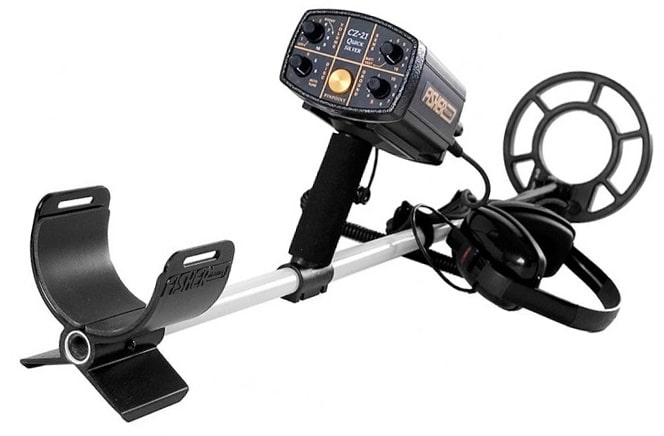
This is a fantastic metal detector from Fisher that can plunge 250 feet under water in either fresh or saltwater, making it extremely versatile and capable of consistently producing excellent results. It starts with a click of a button and pinpoints precisely, and it also performs well in mineralized soil.
It has a 3-tone audio target ID and an all-metal auto-tune mode. It comes in two sizes: an 8-inch coil and a 10-inch coil, both of which are highly efficient and ideal for beach hunting or ping into the sea.
4. Nokta Makro Simplex+
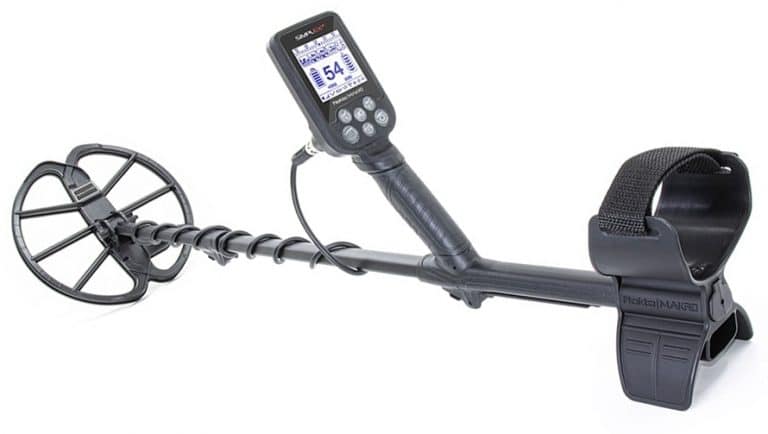
If you're new to metal detecting or ping underwater, you may like to start with a low-cost alternative before upgrading to a higher-end system. The Simplex+ from Nokta Makro is the best budget underwater metal detector. The Simplex+ is an excellent entry-level system which can be used on land as well as underwater. It has five search modes: notch discrimination, iron length, frequency shift, and frequency shift for different terrains.
Wireless headphones are included, but they are not waterproof. You'll see why the Simplex+ made the list when you see it underwater. When a target is found, it vibrates, which is useful because you can't use the headphones underneath the water. For all those that enjoy night pes, there's also a flashlight and a backlit display. The digital control panel is simple to use since it uses thumbnail icons to show which mode you're in. It has the standard numerical target ID, battery & depth indicators, as well as easy-to-use buttons for changing settings.
5. Wedigout Underwater Handheld Metal Detector
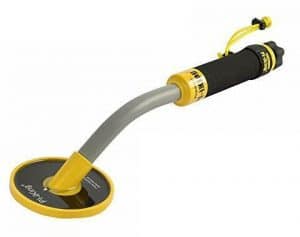
This is one of the simplest and cheapest metal detectors for underwater treasure hunting. The Wedigout Underwater Handheld Metal Detector is a reasonably priced model that performs admirably, especially when used underwater.
This metal detector is compact enough to function underwater and features a waterproof seal that enables the pinpointer to operate at depths of up to 100 feet.
The MD-750 uses pulse induction technology that ensures that its detection range is unaffected by the water in which it is used. This ensures you could use it to search for metals in freshwater and saltwater, as well as in sandy environments.
When you don't have a lot of gear, the handheld lightweight design makes it very simple to use underwater.
The Wedigout MD-750 has a built-in microprocessor which provides a consistent and high degree of sensitivity, which is impressive given its design and price!
This microprocessor also adjusts its sensitivity automatically, saving you time and allowing you to concentrate on finding underwater treasures.
You won't need to buy any extra headphones because the metal detector works by vibrating and illuminating a LED indicator if it detects targets.
Coil Size
The coil size of a metal detector is another feature that is often ignored.
Large Coils
Larger coils will definitely provide you with a significantly greater depth and detection area, allowing you to cover more area quickly.
A metal detector with such a big coil, on the other hand, has certain drawbacks, the most significant of which is the added weight.
When you upgrade a metal detector's coil from a smaller to a larger variety, you'll note a significant weight gain.
Any manufacturer can create a detector that is well-balanced when the stock coil, meaning that the weight is evenly distributed.
When you replace this with a larger coil, the whole weight balance of the detector is thrown off, and you can feel the impact of the larger coil dragging the detector down right away.
Although you might be able to manage the weight, it will become a challenge in the longer term if you use it for long periods of time.
Additionally, a larger coil results in increased surface tension/resistance when swinging the metal detector in the water.
Small Coils
Since you can't see the ocean floor, smaller coils are simpler to manage and have more precise pinpointing.
Small coils are also suitable for beach shooting, where target separation is crucial due to the abundance of garbage on the beach.
But even so, using a smaller coil means that the area covered is smaller; consequently, you spend more time.
Pulse Inductions vs Very Low Frequency (VLF)
There are 2 types of metal detectors which are suitable for use in sea water.
Pulse induction (PI) metal detectors use a technique that involves firing repeated bursts of electrical pulses in to ground and receiving a signal if they strike anything metal.
They are better for saltwater because they can handle higher mineralization, but are not as discriminating as VLF machines.
If you buy a pricey top-of-the-line machine with high sensitivity, you'll pick up everything, including iron and garbage.
Extremely low frequency machines detect at a low frequency, and their technology allows you to discriminate more effectively.
A successful ground balancing VLF machine would neglect mineralized dirt, allowing you to find the treasure instead of a rusted nail.
VLF computers, in the blue corner, are unquestionably more flexible. They have reasonable discrimination on mineralized ground and can be used on soil, saltwater, and freshwater. They're often usually lighter than pulse machines.
A pulse induction system (PI) detects deeper, smaller particles than VLF detectors and is designed to disregard ground minerals. There's no need to make any adjustments; simply grab and go.
A PI metal detector is recommended if you'd like to mainly search underwater in salty environments. If you prefer freshwater, feel free to pick whichever one you prefer.
Why is pulse induction better for metal detecting in salt water?
Metal detecting in seawater is difficult because it is a unique environment. Since most metal detectors are ineffective in salt water, you'll need a dual-function VLF or PI metal detector. While PIs are best for coping with sea water because they are unaffected by its conductivity or the mineralization of sediment or sand, VLF detectors with a salt water mode are also available.
Weight & Buoyancy
When you're using your metal detector underwater, the very last scenario you want is for it to get dropped and see it plummet into the depths, never to be seen again because of its heavy weight.
You wouldn't really want it to be light and buoyant, however, that it begins bobbing to the surface when you're trying to search along the seabed. You want a water detector with ‘neutral buoyancy,' which means it sits in the center. Check the net weight of every detector you're thinking of purchasing and pick the one that seems to be best for your needs.
What is a Metal Detector's IP Rating?
IP, or “ingress protection”, ratings are international standards that describe the efficacy of electrical products in sealing out moisture and foreign objects including dirt and debris.
Electrical goods are sometimes given an IP rating, such as “IP67” or “IP65,” but just because these get an IP rating does not mean they are water-resistant. If you do not really understand what these numbers mean in the real world, they're meaningless to you.
IP numbers are extremely popular among marketers, and they used to be a bit of a mystery to the general public. If you are not familiar with these ratings, I would recommend that you stick with buying an underwater metal detector from a major manufacturer like Garrett or Minelab.
Chest Harness
You may or may not require a chest harness, although it can be extremely beneficial if you are using a heavy metal detector. When you move something from side to side for a few hours, even a metal detector that is just a few pounds will feel a lot heavier. The fact that the waves will pull the metal detector constantly doesn't help matters.
A strong chest harness will take the weight off your arms and make exploration safer by allowing you to maintain your balance and steadiness.
Are underwater metal detectors good for beginners?
Using an underwater metal detector when scuba ping would be most beneficial to those who are experienced in metal detecting and ping. You'll be able to comfortably submerge 200 feet under the surface to find the well-hidden riches beneath the surface.
If you're new to scuba ping or metal detecting, though, it may be a safer idea to work on getting your skills on land first. If you've a novice at metal detecting, I would suggest that you look at these metal detectors for beginners first.
Search Depth
The search depth of a metal detector refers to how far it can search for conductive metal. The average depth of a search varies greatly between items, ranging from around 2 inches to 15 inches. High-frequency detectors have a lower maximum depth rating than lower-frequency detectors.
Keep in mind that the scope of your search isn't solely determined by the metal detector you're using. The depth of your metal detector's search can be reduced or increased depending on your position, the type of ground you're dealing on, and noise above or below surface.
Related Articles
Best All-Around Metal Detectors
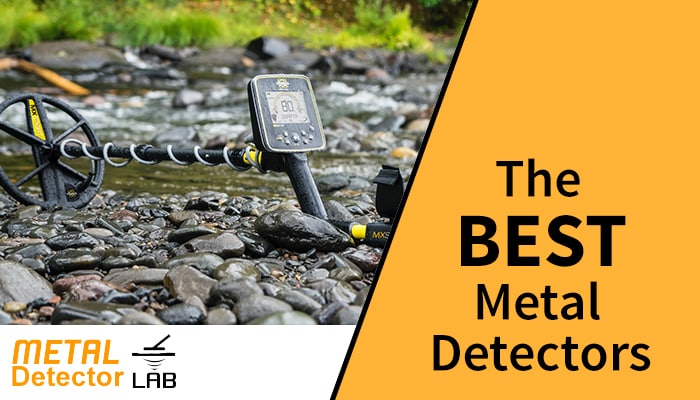
Our guide to choosing the best metal detector for your use, budget, and experience.
Metal Detectors for Gold and Silver Coins
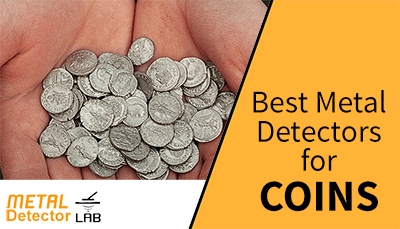
Specially designed coin shooting metal detectors are best for finding gold and silver coins.
MetalDetectorLab.com is reader supported. When you buy through links on our site, we may earn an affiliate commission.

